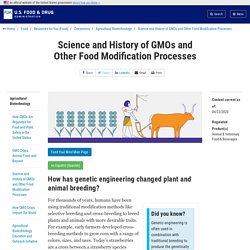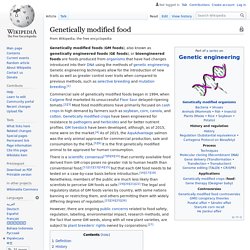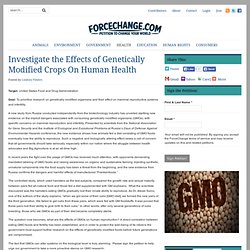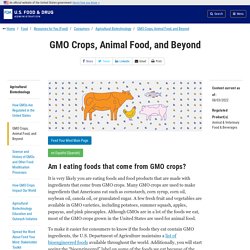

Home - Library Home - LibGuides at Nazareth Catholic College. Pamela Ronald. GM Food - Interview contacts.
Genetically Modified Foods. What is genetically modified food? - BBC What's New? Lecture on Genetically Modified Foods by Dr. Aditi Bhatnagar. Science and History of GMOs and Other Food Modification Processes. Feed Your Mind Main Page en Español (Spanish) How has genetic engineering changed plant and animal breeding?

Did you know? Genetic engineering is often used in combination with traditional breeding to produce the genetically engineered plant varieties on the market today. Genetically modified food. Foods produced from organisms that have had changes introduced into their DNA Genetically modified foods (GM foods), also known as genetically engineered foods (GE foods), or bioengineered foods are foods produced from organisms that have had changes introduced into their DNA using the methods of genetic engineering.

Genetic engineering techniques allow for the introduction of new traits as well as greater control over traits when compared to previous methods, such as selective breeding and mutation breeding.[1] Commercial sale of genetically modified foods began in 1994, when Calgene first marketed its unsuccessful Flavr Savr delayed-ripening tomato.[2][3] Most food modifications have primarily focused on cash crops in high demand by farmers such as soybean, corn, canola, and cotton. Genetically modified food. Pamela Ronald: The case for engineering our food. GM safe article. The rise of Frankenfoods genet. General information about GM foods. Page Content (August 2019) People have been manipulating the genetic make-up of plants and animals for countless generations.

This is referred to as traditional cross breeding and involves selecting plants and animals with the most desirable characteristics (e.g. disease resistance, high yield, good meat quality) for breeding the next generation. Today’s techniques use new ways of identifying particular characteristics and transferring them between living organisms. For example, it is now possible to make a copy of a particular gene from the cells of a plant, animal or microbe, and insert the copy into the cells of another organism to give a desired characteristic. Investigate the Effects of Genetically Modified Crops On Human Health. Target: United States Food and Drug Administration Goal: To prioritize research on genetically modified organisms and their effect on mammal reproductive systems and infertility.

A new study from Russia conducted independently from the biotechnology industry has unveiled startling new evidence on the implicit dangers associated with consuming genetically modified organisms (GMOs), with specific concerns on mammal reproduction and infertility. Presented by scientists from the National Association for Gene Security and the Institute of Ecological and Evolutional Problems at Russia’s Days of Defense Against Environmental Hazards conference, the new evidence shows how animals fed a diet consisting of GMO foods eventually lose the ability to reproduce. Such a negative and biologically altering effect raises a call of concern that all governments should take seriously, especially within our nation where the struggle between health advocates and Big Agriculture is at an all-time high.
Sincerely, eBooks - Document - Genetically Modified Foods. Genetically Modified Foods and Social Concerns. GMO Crops, Animal Food, and Beyond. Feed Your Mind Main Page en Español (Spanish) What GMO Crops Are Grown and Sold in the U.S.?

Am I eating foods that come from GMO crops? It is very likely you are eating foods and food products that are made with ingredients that come from GMO crops. Many GMO crops are used to make ingredients that Americans eat such as cornstarch, corn syrup, corn oil, soybean oil, canola oil, or granulated sugar. To make it easier for consumers to know if the foods they eat contain GMO ingredients, the U.S. What GMO crops are grown and sold in the United States? Only a few types of GMO crops are grown in the United States, but some of these GMOs make up a large percentage of the crop grown (e.g., soybeans, corn, sugar beets, canola, and cotton). In 2018, GMO soybeans made up 94% of all soybeans planted, GMO cotton made up 94% of all cotton planted, and 92% of corn planted was GMO corn.
Food, Genetically modified. In Context: High School - Document - What facial recognition technology means: The future of the surveillance state. Facial Recognition Technology: Here Are The Important Pros And Cons. When you post a photo on Facebook, and the platform automatically tags the people in the image, you might not give much thought to the technology behind the convenience.

However, when you discover that facial recognition technology could track you without your permission while you walk down a street in London, it might make you question the invasion of your privacy. Just like with any other new technology, facial recognition brings positives and negatives with it. Since it’s here to stay and expanding, it’s good to be aware of the pros and cons of facial recognition. What is facial recognition, and how does it work? Facial recognition is a biometric technology that uses distinguishable facial features to identify a person. Today, we are inundated with data of all kinds, but the plethora of photo and video data available provides the dataset required to make facial recognition technology work.